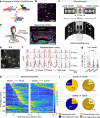Hippocampal astrocytes modulate anxiety-like behavior
- PMID: 36344520
- PMCID: PMC9640657
- DOI: 10.1038/s41467-022-34201-z
Hippocampal astrocytes modulate anxiety-like behavior
Abstract
Astrocytes can affect animal behavior by regulating tripartite synaptic transmission, yet their influence on affective behavior remains largely unclear. Here we showed that hippocampal astrocyte calcium activity reflects mouse affective state during virtual elevated plus maze test using two-photon calcium imaging in vivo. Furthermore, optogenetic hippocampal astrocyte activation elevating intracellular calcium induced anxiolytic behaviors in astrocyte-specific channelrhodopsin 2 (ChR2) transgenic mice (hGFAP-ChR2 mice). As underlying mechanisms, we found ATP released from the activated hippocampal astrocytes increased excitatory synaptic transmission in dentate gyrus (DG) granule cells, which exerted anxiolytic effects. Our data uncover a role of hippocampal astrocytes in modulating mice anxiety-like behaviors by regulating ATP-mediated synaptic homeostasis in hippocampal DG granule cells. Thus, manipulating hippocampal astrocytes activity can be a therapeutic strategy to treat anxiety.
© 2022. The Author(s).
Conflict of interest statement
The authors declare no competing interests.
Figures






References
Publication types
MeSH terms
Substances
LinkOut - more resources
Full Text Sources
Molecular Biology Databases
Research Materials

